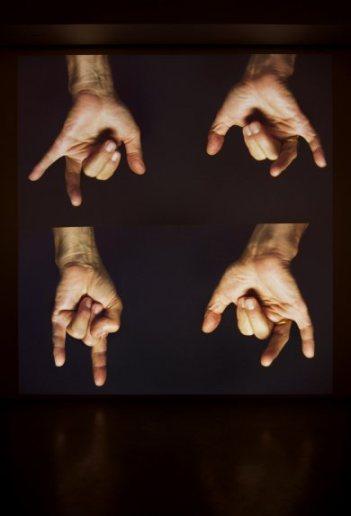It’s easy to describe Bruce Nauman’s For Beginners (all the combinations of the thumb and fingers). There it is, right in the title: two sets of hands displayed on a large, two-sided screen, palms facing out as two voices command different combinations of fingers and thumbs to close. Five fingers in a row, combinations of four fingers in a row, three fingers, and so on.
![ForBeginners204[1]](/sites/default/files/attachments/forbeginners2041.jpg)
Bruce Nauman, For Beginners (all the combinations of the thumb and fingers), 2010, collection of the Los Angeles Museum of Art and Artis, Image courtesy Sperone Westwater, New York. © 2011 Bruce Nauman / Artists Rights Society (ARS), New York
It’s easy to describe what it is, sure, but it’s harder to describe what it does. That’s largely because, despite the work having a huge, imposing visual element, the sound of the video piece is dominating. The two voices instructing the hands are, more specifically, two sets of the same voice, each instructing the fingers to open and close in different intervals. For instance, while one voice speaks “third finger, fourth finger, thumb, first finger,” the other is saying “first finger, second finger, third finger,” and so forth. They speak over each other, at equal volume and tone. The artwork occupies its own gallery on the first floor of BCAM, where the voices echo through the spacious room. On entering the other day, it sounded to me like cacophony. The longer I listened, however, the more musical it became. And by musical I’m thinking less of Beyoncé, more of Steve Reich, whose early works involved tape loops of the same voice played at slightly different speeds, causing them to fall out of phase before eventually synching back up again. Nauman’s voices are not exactly the same as Reich's loops, but a similar thing is happening—just when the dual instructions seem a barrage of confusion, they suddenly, coincidentally, powerfully, come together to say THUMB. It hits so abruptly and with such clarity that it has the power of a drum or cannon shot. At one point as I sat in front of the screens the voices hit onto a whole string of simultaneous commands—”first finger, second finger, third finger”—before jogging away from each other again. I started listening for patterns, intentional or not. It became hypnotic (aided by the lulling images of the giant fingers in front of me, opening and closing, opening and closing, opening and closing). A colleague of mine equated it to a Gregorian chant. In a way, yes—the voice is deep and commanding—but the rhythm is all wrong. So I started thinking about the cadence of the voice. And suddenly I realized: it was a waltz! “SECOND fin-ger / THIRD fin-ger / FOURTH fin-ger / THUMB.” Or, something approaching a waltz; it is plain speech, not song. I find that I, personally, tend to become enamored of sounds before visuals (if that isn’t apparent). That isn’t true for everyone, for sure. In the fifteen minutes I’d spent with For Beginners, it became more and more like a kind of music to me. That didn’t seem to be the case for the guard positioned in the gallery. She asked me if I liked the piece and I told her I thought it was great. She sort of winced, then asked if we could trade jobs for the day. I almost took her up on it. Scott Tennent



